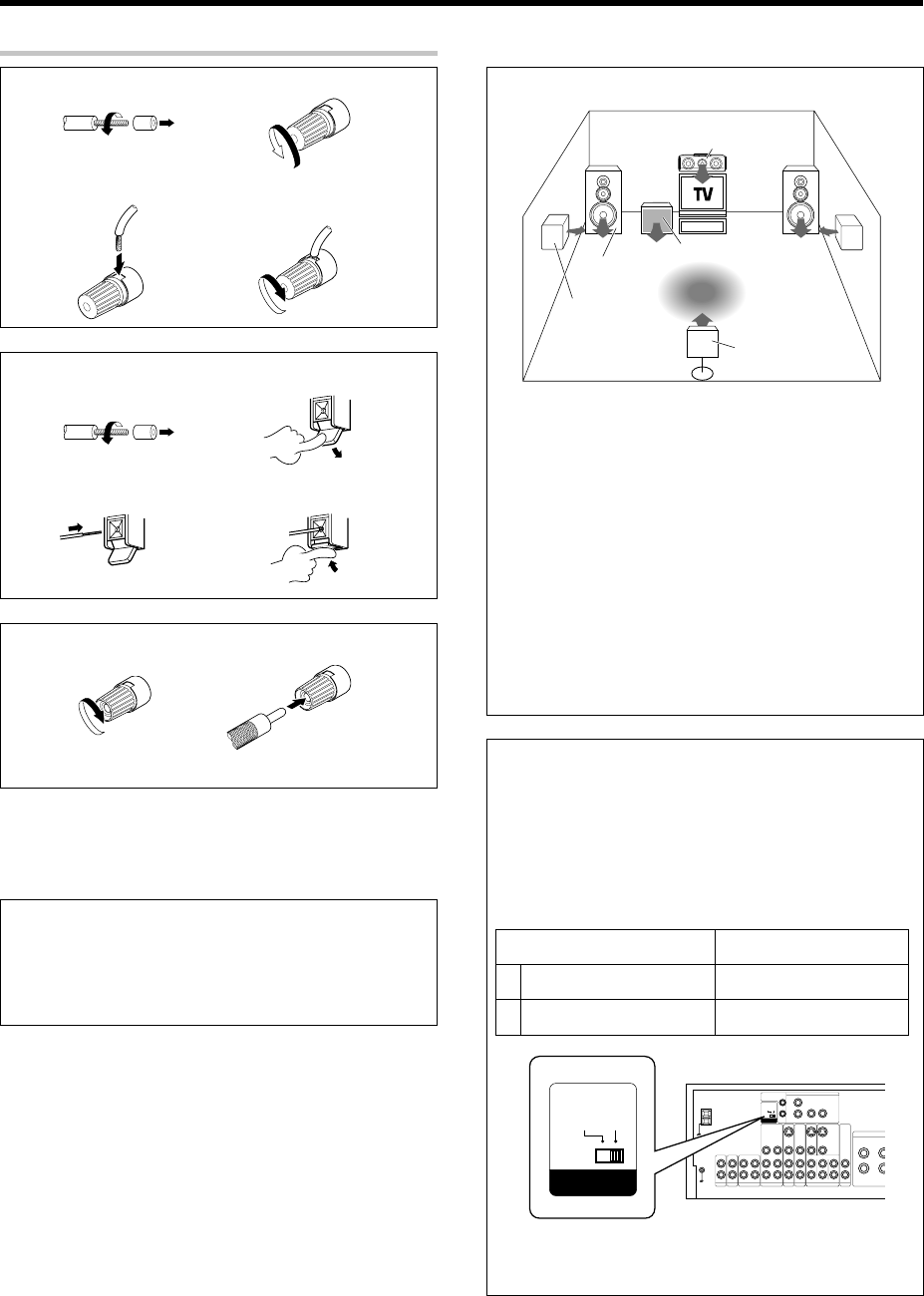
15
EN
Setting up the system
Connecting the terminals
1 Strip coating. 2 Loosen.
3 Insert. 4 Secure.
1 Strip coating. 2 Push the lever.
3 Insert the cord. 4 Return the lever.
Connection of banana plugs (For the U.S.A. and Canada)
1 Secure. 2 Insert.
•Sound will not be heard if the speaker terminal is not fully secured.
•Never short circuit the + and – speaker cords.
•If the left and right speakers are connected inversely or the speaker
cords are connected with reversed polarity, the sound will be
unnatural with ambiguous acoustic imaging. Be sure to connect the
speakers correctly.
Speaker impedance
After confirming the speaker impedance indications printed on the
rear panel of the receiver, connect speakers with matching imped-
ance ratings. Using speakers with a rated impedance other than that
indicated on the rear panel of the receiver could result in malfunctions
or damage to the speakers or receiver.
Speaker placement
Front speakers : Place at the front left and right of the listening
position. Front speakers are required for all surround modes.
Center speaker : Place front and center. This speaker stabilizes the
sound image and helps recreate sound motion. Required for surround
playback.
Surround speakers : Place at the direct left and right, or slightly
behind, the listening position at even heights, approximately 1 meter
above the ears of the listeners. These speakers recreate sound
motion and atmosphere. Required for surround playback.
Subwoofer : Reproduces powerful deep bass sounds.
Surround back speaker : Place the speaker directly at the rear of the
listening position. The optimum position depends mainly on the room
condition.
•Although the ideal surround system consists of all the speakers
listed above, if you don't have a center speaker or a subwoofer, you
can divide those signals between the available speakers in the
speaker settings steps to obtain the best possible surround repro-
duction from the speakers you have available. *
Channel space switching
(Except for the U.S.A., Canada, U.K., and Australia)
The space between radio channels has been set to the one that
prevails in the area to which the system is shipped. However, if the
current channel space setting does not match the setting in the area
where the system is to be used, for instance when you move from
area 1 or area 2 shown in the following table or vice versa, proper
reception of AM/FM broadcasts cannot be expected. In this case,
change the channel space setting in accordance with your area by
referring to the following table.
Area
CHANNEL
Space Frequency
1
U.S.A., Canada and South FM: 100 kHz
American countries AM: 10 kHz
2 Other countries
FM: 50 kHz
AM: 9 kHz
50us
AM 9kHz
FM50kHz
75us
AM 10kHz
FM100kHz
DE-EMPHASIS
CHANNEL SPACE
DE-EMPHASIS
CHANNEL SPACE
50us
AM 9kHz
FM50kHz
75us
AM 10kHz
FM100kHz
Turn the power OFF by pressing the POWER key before moving the
switch level. Move switch lever to match your area with a small
screwdriver or other pointed tool, then turn the power on again.
Center speaker
Subwoofer
Front speakers
(L,R)
Surround
speakers
(L,R)
Listening
position
Surround
back speaker
•VR6050/10-18/EN 4/9/02, 4:53 PM15


















